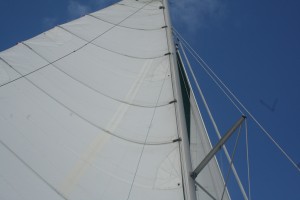Sail Away!
We take so many things for granted on land. Water appears to pour from an endless well and electricity is immediate at the flick of a switch. On the ocean, however, these luxuries have to be rationed as we can only use what we can store. In addition, any waste products, such as black water, have to be stored, and disposed of responsibly. Whilst out at sea, for example, human waste was carried around with us until it could be ‘pumped out’ at Roche Harbor. The Gato Verde had two holding tanks for the purposes of storing human waste. The three weeks spent on the Gato Verde have certainly helped me to understand and appreciate how much more sustainable we can all live. In the past when I have heard the term sustainability, I have automatically associated this with either a big change in lifestyle or a large investment. The reality, however, is that we can all live healthier and more sustainable lives if we just use things in moderation.  Whilst out on Gato, as part of our morning chore rotations, measurements were taken of water usage, sewage level, and amount of biodiesel used. This allowed us to graph and monitor our footprint over the duration of the trip.
Compared to many vessels, the Gato Verde, a 42 ft electric biodiesel hybrid catamaran , is pretty special in that it was modified to be more environmentally friendly. Such modifications include converting to LED lights, and changing the sail plan to optimize efficiency. This involved adding a screecher to take full advantage of any wind, and by making the main sail a ‘square top’ to increase surface area. There is no cleaner fuel than the wind itself. If there is little wind then the Gato uses quiet electric motors to help it move through the water. Compared to most motors, these have little noise impact on the environment. The Gato also burns biodiesel, a renewable fuel source, that not only powers the vessel through the water, but, also can be utilized to charge the boats batteries.  Despite the Gato’s current success in being sustainable, further modifications are being considered for the foreseeable future. In the short term, Captain Todd hopes to add solar panels and a wind generator to be even more energy independent. Research is also being directed into alternative grey water systems.
Although we were busy collecting physical oceanography measurements such as conductivity, salinity, visibility, and plankton density, there were a number of opportunities for us to learn about the Gato and the process of sailing. In the early stages, there was so much terminology to get our heads around and knots such as bowlines and sheet bends seemed impossible. In the latter part of our trip, however, this new language felt a lot more natural. For example, when asked to pull in the jib, I knew that this was the middle sail (not to be confused with the main sail or screecher). The masts supporting these sails were themselves held in place by a forestay and shrouds. Out of all the sails, we used the jib the most as it is designed to operate in lighter winds. By using the wind to our advantage, less fuel was needed to travel the same distance. In addition to using the wind, tides and currents were also exploited. By using the environment we could ultimately be more sustainable. After long days of science, we would head back to either moor or dock on nearby islands. Out of all the places we visited, my favourite was Patos Island. On occasions, we were forced to anchor. This however was avoided wherever possible because of the damage it inflicts on the marine environment. Towards the end of the two weeks, we could prepare the anchor with as little as two students. We were mostly responsible for directing Captain Todd, operating the windlass, and preparing the bridle. The idea behind the bridle is that once attached,  it helps to distribute the stress on the boat. The final stage of the  anchoring process involved attaching the chain hook.
It was a sad moment when the Gato sailed off from the Friday Harbor labs. Although I was happy to be back on land, I am now itching to get back on the water. I feel that living onboard the Gato has prepared me well for the future. In the space of two short weeks we have learnt so much, skills that will last a lifetime.





 Twitter
Twitter LinkedIn
LinkedIn Facebook
Facebook